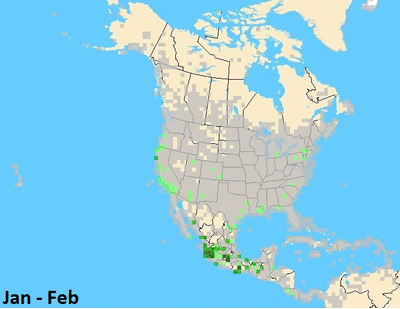I am very excited as this is the time of year when they arrive where I live. I have often wondered where they winter. When they migrate north, what route(s) do they take? Well, eBird (meaning all of you as eBird users!) can help us answer that.
I put together the following animated map which shows Bullock's Oriole range by month. I hope eBird will at a future date allow me to look at the range by week as they tend to move pretty quickly in April and May and I think we can learn a whole lot more by looking at weekly details.
 What can we learn from this month-by-month map?
What can we learn from this month-by-month map?First, Bullock's Oriole appear to winter in Mexico, particularly along the western side of Mexico.
By March, they are all over California and the lower half of Arizona.
In April they began to spread until May when they spread dramatically across the western United States following the continental divide as if it was some invisible wall. Bullock's Orioles even make their way up into parts of British Columbia and Alberta.
June and July show that reports are more localized, but still covering the same range. This makes me think that they are on nesting grounds and not traveling to and fro so much. By September, the southern migration is well underway.
It also appears that the best chance for our friends in the eastern half of the United States to see a Bullock's Oriole is for a winter vagrant...those silly birds that got their instinct wires crossed and head east rather than south.
Bird migration is such an interesting phenomenon and pondering it stirs my soul with wonder and amazement!



Terrific post coupled with a beautiful photograph! I will have to check out this wonderful feature on eBird. Fascinating!
ReplyDelete...cool post. I love that map in action! I don't think I'm going to see this bird any time soon in my backyard! :-)
ReplyDeleteThe invisible wall seems to be, not the Rocky Mountains, but the 100th meridian. An even more invisible wall than the Rockies.
ReplyDeleteAwesome map, irregardless.
@Julie G. - I took that photo in Idaho last year. Bullock's are eye candy indeed. eBird is making their heat-maps of a few species at a time, they just haven't gotten to the Bullock's Oriole yet, so I make my own animated maps using Picasion.com.
ReplyDelete@Kelly - I'll trade you a few Bullock's Orioles for a few of your warblers!
@Anonymous - you are correct about the 100th meridian. Your comment prompted me to go back and look at a map of the actual continental divide. The Bullock's Oriole does get pretty well east of the divide and that imaginary wall on the 100th meridian is pretty dead on.
Quite a surprise for me to spot this beautiful bird in the back yard ficus hedges the last two winters in Coral Springs, Fl (Ft. Lauderdale area). Haven't seen one in 2012...flock of cedar waxwings up in the tree tops which I assume are migrating back north. Also, an occassional Downey Woodpecker....it's a treat to see these birds so far south.
ReplyDeleteI have had these delighfulbirds nesting in my weeping willow trees in south central Oregon for several years now, they start appearing in late May showing up at my 4 feeders. I can sit on my back porch swing and watch them build their nests, amazing. When the young take off my feeders really get busy, need filling daily. They will be heading south soon leaving me with great memories of a fun filled summer watching them grow into fat healthy birds.
ReplyDeleteWe have had these gorgeous Bullock's Orioles in our yard for the four years that we've lived in Colorado. One question. It seems to me that the males show up in the spring earlier than the females. And it also appears to me that they leave before the females and immatures in the late Summer/early fall. Have you noticed that?
ReplyDelete